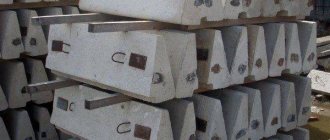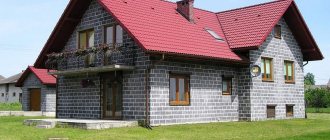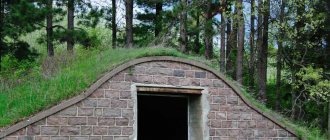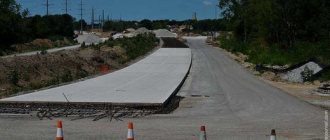For many years now, a swimming pool in a suburban area or in a country house has been perceived not as a curiosity, but as part of a comfortable life. At the same time, it is a complex and expensive structure, especially if it is a concrete pool. For those who have decided to turn their dream into reality and build a pool on their own, with minimal investment, it will be useful to get acquainted with the construction plan. I propose to understand each stage, from project development to finishing work and landscaping.
Location of technical room Source romstal.ua
Layout, choice of design and location
When deciding to build a concrete pool, owners must decide two important issues:
- Fundamental possibility of construction. In an area with high groundwater, it is recommended to abandon a concrete pool in favor of another design.
- Selecting the bowl volume. If the volume exceeds five cubic meters, then such a structure must be registered with the BTI, and construction must begin only after obtaining permits.
The location for the concrete bowl is selected taking into account the characteristics of the site and the following recommendations:
- The structure is laid at a distance from a residential building and buildings with a foundation in order to exclude a negative impact on their integrity.
- Trees should not be planted near the bowl: their root system can grow and destroy the concrete. In addition, trees are an excellent source of small debris.
- If you have a choice, it is better to place the bowl in a place with clay soil. It will serve as a natural barrier to groundwater.
- Whenever possible, consider wind protection.
- The construction site must be convenient for access by construction equipment.
Project with concrete stairs Source maja-dacha.ru
Construction of a concrete pool
A pool with a concrete bowl does not differ much in design from other types. It has the same systems that do the necessary work to maintain the water in the required condition.
Construction of an artificial reservoir and its systems
Concrete pool systems:
- Pump;
- Thermostatic devices;
- Filters of various types.
It is also possible to install additional devices:
- Automatic chemical dispensers;
- Contour lighting;
- Hydromassage, counter current, waterfalls, fountains;
- Slides, jumps and other attractions.
Holes for nozzles for collecting and returning water to the bowl are installed immediately when pouring concrete. Next, a circuit consisting of a pump, filter and heater is connected to them. The procedure for connecting this equipment depends on your conditions and device models. After installing the circular chain, consider that the pool is ready for use.
You can install additional equipment after completing all construction work, but it is still better to think through everything in advance and do it in one go.
Now let's look at each stage in great detail.
About the technical project
Once the location has been chosen, the development of the technical design can begin. Construction work will be carried out according to this document, so all the nuances are spelled out in it:
- Construction technology, calculation of strength and durability.
- Pool parameters, including bowl shape, size and depth. Drawings are developed and dimensions are set.
- The configuration of utilities is selected. You need to think about how to fill the bowl and drain the water, and where to place the cleaning filters. You may need a heating or lighting system.
Concrete and other materials
Concrete pools have an impressive lifespan of about 60-80 years. But to make the bowl durable, you need high-quality construction materials to build a pool. The main building material, concrete, is chosen taking into account the characteristics of outdoor use. You will need concrete that is not only highly waterproof, but also resistant to temperature fluctuations, in particular frost.
Sectional view of the pool bowl Source shortpixel.ai
Experts agree that concrete should be used for structures with significant mechanical and atmospheric loads. The M350-M400 brands meet these criteria. Pay attention to additional indicators: water resistance (W6 brand is suitable) and frost resistance (F200).
I advise you not to skimp on concrete; the consequences of saving can be disastrous. If you are going to model the bowl yourself, give preference to heavy concrete from trusted manufacturers. Such brands contain hydrophobic (organic or mineral) additives and plasticizers.
To improve the quality of the bowl, equipment for vacuum and vibration processing of concrete (vacuum pump, construction vibrator) is used. Treatment helps to make the concrete pool bowl more dense, reduce the size of capillaries, and also eliminate the appearance of defects (sinks).
High-quality concrete will be the key to long-term operation Source folksland.net
If you plan to prepare the concrete mixture yourself, use the following proportion (per 1 cubic meter):
- Cement M400: 600 kg.
- Medium granulation sand: 1500-1600 kg.
- Fiber fiber (to increase strength): 800 kg.
- Plasticizer: 1 kg.
- Water. It is added according to the ratio: for one part of the material - 0.3 parts of water (the part is the weight of the components, not the volume).
You will also need reinforcement to strengthen the walls and installation equipment. Some hardware stores offer pool equipment kits, but you can assemble everything you need separately. You will need nozzles and flanges, a ladder, a pump with a filter, a skimmer, as well as finishing materials (mosaic, tile, PVC film).
Using technology will save a lot of time and effort Source stroypomochnik.ru
See also: Catalog of companies that specialize in designing and performing landscape work of any complexity
Approximate calculation of the cost of future construction
Having a completed project in hand, it will not be difficult to make an estimate of future expenses. The more seriously you take the design stage, the easier it will be to make not only an approximate, but a fairly accurate calculation of future financial expenses. The prices for building materials are known, catalogs of construction stores are available on the Internet, you can visit local construction markets and stores, find out the prices for the necessary goods and choose from them those that are acceptable and suit you. Let's try to figure it out together with you:
- For example, in the given step-by-step instructions for a pit pool, it is necessary to fill the bottom with sand to a height of 30 cm. We calculate, starting, for example, from the size of the pool 3*4 m: 3*4*0.3 m - 3.6 cubic meters of sand will be needed to fill the bottom of the future pool and concrete, this is 1000 rubles. Waterproofing with roofing felt (2 rolls 1*10 m) will cost 700 rubles;
- The consumption of crushed stone for the pool, which is necessary for the construction of the foundation and the bowl itself, will be the same - 3 cubic meters, cost - 800 rubles;
- The main costs will be for concrete, tiles and pool equipment;
- The work of an excavator today will cost approximately 14-15 thousand rubles;
- Two-tier foundation reinforcement will cost 3,500 rubles. The reinforcement for the walls will cost a little less - 3,200 rubles;
- It will take about 5 cubic meters of concrete to pour the foundation and walls; with delivery it will cost 15 thousand rubles;
- Waterproofing the bowl will cost 3 thousand rubles;
- Internal tiling 45 thousand rubles;
- The most inexpensive equipment for filtration and water purification will cost 25 thousand rubles;
- The total amount comes out to 112 thousand rubles.
The above prices are current at the end of 2022 for the central regions of Russia.
Preparation: site and pit
The first step is to plan the site: determine the exact location of the bowl, mark the outline with pegs and rope. It is important to take into account the size of the construction site itself: they should be so large that it is convenient to use machinery and small-scale mechanization.
When the markings are ready, the construction of a concrete pool begins with digging a pit. For digging, it is worth using an excavator, since manual work is labor-intensive and will take a lot of time. The walls of the pit are made with a slope to avoid scree. The bottom is constructed with a slight slope (5-7%), at the lowest point a recess is dug for a drainage well. Then prepare the sand and gravel bed in the following order:
- Crushed stone is poured into the drainage well and compacted.
- The bottom is covered in layers of sand (20-30 cm) and gravel (10 cm); Each layer is carefully compacted. At the same time, a hydraulic system for filling and draining water is laid, not forgetting the need to slope the drain pipes (4-8%).
- The bottom is waterproofed using roofing material, PVC film or bitumen mastic.
The bottom must be made with a slope Source natucer-fd28.kxcdn.com
backfilling
If the soil is not heaving, the previously removed rock can be filled and compacted into the gap between the pool wall and the bottom of the pit. Otherwise, it is better to fill it with crushed stone. It will partially compensate for winter heaving. In general, in winter, water in outdoor pools is drained only below the level of nozzles and skimmers. Frozen ice partially compensates for the pressure from the ground. And to prevent the ice from destroying the walls, plastic eggplants are thrown into the water, which should be about half submerged (you can add a little sand). When the ice freezes, they take on most of the load. The walls remain intact.
Ready pool
Construction of the bottom of the bowl
The bowl is the central and most labor-intensive part of the pool. Its construction begins by filling the bottom with concrete mortar. If you can fit special equipment to the pit, it makes sense to purchase ready-made concrete mortar. But you can also prepare it yourself using cement (325 kg), sand (625 kg), water (170 l) and crushed stone (1250 kg).
The bottom also needs to be reinforced with reinforcing mesh. For its manufacture, rods with a diameter of 12-18 mm are used; The cell size is 15-25 cm. It is not necessary to weld the rods; it is enough to secure them together with thin wire. Filling is performed in two ways:
- Pour a layer of concrete 5 cm thick. Wait for the concrete screed to dry, lay out the reinforcing mesh and fill it with the second layer of screed.
- For those who want to make a concrete pool faster, the second method is suitable. Pouring is done in one step: first, a reinforcing mesh is assembled, which is placed on bricks (or other supports) to maintain the distance to the pillow. Then pour out all the concrete solution to cover the reinforcement.
Fragment of reinforcing mesh Source ytimg.com
Plastering
First, a plaster metal mesh is fixed to the finished concrete wall. They work with a solution with waterproof qualities. You can either buy ready-made mixtures or add appropriate additives to the standard composition. They are added strictly according to the norm, since excess can only cause harm.
To plaster the walls of the pool, you can use the following composition: cement M-500 (1 part), sand (2 parts), latex additive, microfiber (according to manufacturers' standards). Microfiber will serve as reinforcement and increase the strength of the layer; the latex additive will add elasticity and make the composition water-repellent. As a result, the plaster will not have increased resistance to cracking.
After leveling the walls, you can install the embedded parts - the nozzles themselves and, to this day, the drains and backlights are installed. They are sealed with special cords, then the joints are additionally coated with sealants. To ensure greater tightness, sand or cement is poured onto the applied sealant.
After plastering, embedded parts are inserted - nozzles, drains, spotlights, etc.
Construction of bowl walls
When the bottom is formed, wait for the screed to dry, periodically wetting the concrete with water (then drying will be uniform). After the bottom has dried, the walls are poured; the process consists of the following steps:
- Formwork is prepared from boards 30 mm thick; 5x5 cm timber is chosen for the stiffening ribs. If formwork of an unusual (bent) shape is needed, the boards are replaced with laminated plywood. At this point, check that all the necessary mounting holes are filled.
- To reinforce the pool bowl, metal rods with a diameter of 12-20 mm are used (calculated by the project). The rods are placed immediately after pouring the first portion of concrete, until the mixture hardens.
- Concrete is poured in layers; the thickness of each layer is about 15 cm. After 4-5 days, the walls will become hard enough to remove the formwork.
Reinforcing mesh in a bowl of complex configuration Source swimsv.com
- Before pouring the first layer, the base of the walls is moistened; this improves the adhesion of dried concrete and fresh mortar. For the same purpose, aluminum powder is mixed into the first portion of the solution (for the bottom layer).
- There is a second method, when pouring concrete is done at one time. This is argued by the fact that there will be no joining seams between the layers on the walls, and the structure will be homogeneous.
- After pouring, the concrete must strengthen and stand. This may take from two weeks to a month. The concrete surface is periodically moistened with water throughout the drying period.
- If the project provides for a concrete staircase (Roman steps), a separate sheathing is installed for it after the bowl has completely hardened.
Plywood formwork Source kamtehnopark.ru
Reinforcement
To concrete the pool, you will need to prepare low formwork and reinforcement, the rods of which should never be welded. To avoid corrosion, use only wire to fasten the mesh.
The formwork for the pool should outline the outline of the future building. Two levels of reinforcement are neatly laid inside it:
- The first one should rise 5 cm above the edges of the slab.
- The second level is laid 5 cm below the top edge.
- Since a slab about 20 cm thick is usually poured onto the bottom, the distance between two layers of reinforcement should be 10 cm.
Healthy! For difficult soil, use thicker reinforcement.
The pool is reinforced with ribbed rods with a diameter of 10-14 mm and cells 20 x 20 cm, which are laid on small stones. The laying step is 20 cm. You need to step back 5 cm from the edge of the slab and bend the rods with the letter “G” (these bends will be required to create the frame of the walls).
Laying waterproofing
The pool construction technology includes waterproofing, which can be carried out using two methods. Some experts believe that the protective layer should cover the entire surface of the bowl, while others recommend waterproofing only the seams.
The work uses roofing felt sheets, bitumen, and liquid rubber. A PVC membrane and hydrophobic dry (or two-component) building mixtures are suitable. Liquid materials are applied in two layers, preferably with a reinforcing mesh.
When choosing a material, it is necessary to calculate the costs, since the surface of the pool has a fairly large area. The quality of waterproofing can be improved by pre-leveling the walls by sanding.
Thermal insulation
Thermal insulation is used to better retain heat and save energy when heating. It is produced by a spraying process and often hired specialists are called in. The modern market provides kits for self-insulation by spraying polyurethane foam. However, such disposable kits are expensive and not available to everyone.
Thermal insulation of the pool can be done using polystyrene foam sheets. They are laid in a double layer with a total thickness of 5-8 cm so as to cover the seams of the first layer. At the end, water-repellent mastic is applied.
Finishing work and landscaping
The final stage, finishing the pool, is performed in the following order:
- Prepare the surface of the bowl: plaster it with a suitable composition, install embedded elements.
- The edge is decorated with decorative sides, which are laid out of brick or cast from concrete. Additional equipment is installed: hydromassage unit, stairs, slide, counterflow.
- To cover the pool bowl, choose ceramic tiles, mosaics or PVC film; the latter is the most budget option.
Decorative design of the bowl Source pinimg.com
Tiles are chosen most often, but it must be taken into account that there are certain subtleties in its installation. The fact is that under water pressure the surface of the bowl can be slightly deformed. To take into account possible changes, the seam between the tiles is made wide enough.
Also, only elastic adhesives and grouts that can withstand low temperatures are used. If the pool has a complex configuration, mosaic is chosen instead of tiles. After finishing the facing work, allow the glue to dry and fill the bowl again to evaluate the quality of the coating and the operation of the equipment.
The pool is the decoration of the site, so it needs an appropriate frame. You might want to add a roof to it; If there are children in the house, put up a fence. The relaxation area around the pool also needs improvement. To make it comfortable, flower beds are laid out, paths are laid, and space is allocated for umbrellas and sun loungers. A stylish addition would be surface and underwater lighting, a flat, cascading or jet waterfall.
Recreation area with swimming pool Source 8×4.com.ua
Rebar processing
Pool design diagram.
The reinforcement is tied using steel wire. “Windows” are left for installation of embedded parts. Do not use welded frames: strong internal stresses can occur in reinforced concrete. Reinforcement outlets are made along the outline of the bottom slab to fix the wall frame. The bottom formwork is made of waterproof laminated plywood or edged boards.
The reinforcement must be treated with a special anti-corrosion compound to ensure the durability of the structure. Polymer paints are usually used. Standard hot-rolled reinforcement has a layer of iron scale on the surface, the mechanical and physical properties of which are different from the reinforcing material. Scale is quite hard, but brittle.
The connection between it and the base metal has low strength, so when exposed to oxidative reactions, the scale peels off from the base metal. The reinforcement is coated with a polymer, which will create an additional film to protect the metal from corrosion. When applying paint in one layer, there is a high probability of corrosion, since the solvent, evaporating, leaves microscopic unpainted areas on the metal. Double staining is done for higher reliability. When the highest level of corrosion resistance is required, polymer mastics or multi-layer painting are used. To create a protective layer for concrete, special fixatives are used. They ensure the exact position of the frames and maintain the design thickness of the protective layer, which prevents corrosion of the reinforcing steel.
Concrete walls are erected in the same sequence. Rectangular pools are concreted using inventory metal formwork, curved sections are constructed using circles made of plywood and boards. The stability of the formwork is guaranteed by metal or wooden supporting elements.
Briefly about the main thing
A concrete pool is a rather complex structure for a private plot, so a technical design is developed for it, which is then approved and registered with the BTI. Construction includes several stages, from digging a pit to cladding and arrangement of the surrounding area.
Correct execution of each stage will ensure the durability and integrity of the structure. Particular attention is paid to laying the bottom and pouring the walls of the bowl; it is important to use high-quality, frost-resistant and impenetrable concrete. High-quality waterproofing and finishing will make the operation of the structure trouble-free.
To choose, you need to know...
Concrete pools vary in type. These differences may be related :
- with location (indoor, outdoor, adjacent, with sun canopy);
- with size (for decorative accent, for dipping, for splashing, for swimming);
- with shape (rectangular, round, oval, polygonal, figured);
- according to the method of constructing the bowl (prefabricated, cast, monolithic);
- according to design features (overflow or skimmer).











